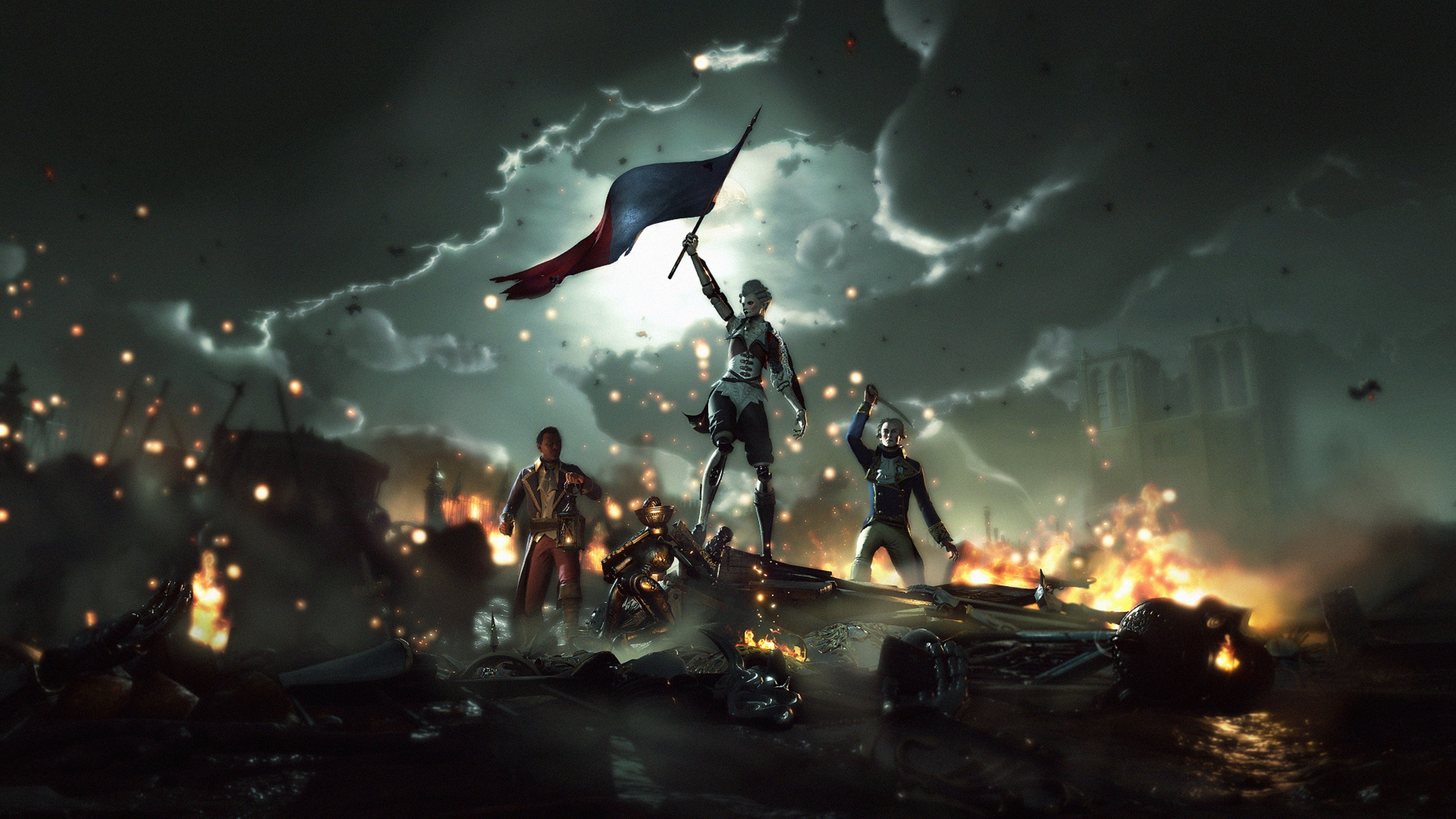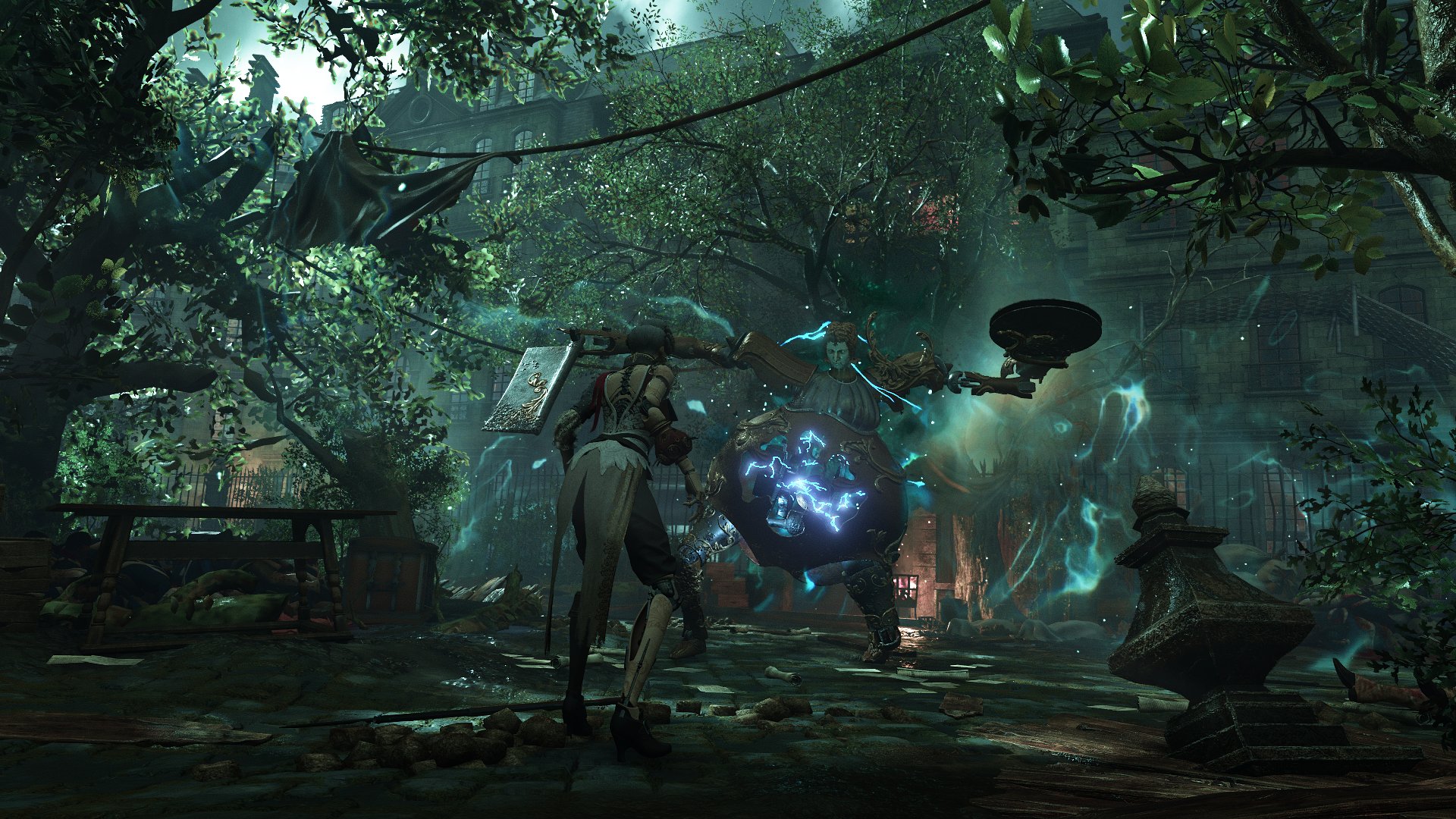Playing Steelrising is one of the strangest experiences I’ve had in recent memory. On the one hand, I enjoyed it as a by-the-numbers Souls-like with serviceable combat, good RPG elements, and interesting traversal. On the other, I was consistently let down by the shallow boss fights, the uninteresting level design, janky graphics, and clunky storytelling.
Steelrising is a game that never falls apart entirely but also reaches for greatness, only never to grasp it.
Steelrising Review: A Wrench in the Gears
While some Metroidvania elements are present, Steelrising stumbles because of its heavy reliance on the Souls-like formula. It’s a good thing that framework is so well established and codified after more than a decade. I shudder to think how this would function without it. That’s because Steelrising is at its strongest when it sticks to its foundations. Find a Vestal (the game’s bonfire equivalent), explore a level, fight some enemies, die, respawn and continue progressing.
Facilitating your progression is a fully functional but relatively rote combat system. You have your light and heavy attacks, plus a Skill unique to your equipped weapon. Dodging outside combat happens in short bursts, but you can cover much more ground when locked onto an enemy. Dodging can be so aggressive that you’ll sometimes go from an enemy’s front around their back to their opposite side, taking one of their sweeping attacks.
As you’re fighting clockwork humanoid contraptions called Automats, animations are janky and sometimes difficult to parse. Enemies also take several hits to stagger, so you can’t simply spam them into submission. You’ll take a more measured approach to combat, attacking once or twice and then waiting for a counterattack. This back-and-forth works fine, but one of Steelrising‘s biggest mechanical sins is poor input queueing.
Every Souls-like has an input queueing system: you press a button in the middle of an animation, and that input will be readied for when the animation ends. Steelrising seems to lock you into an attack without queueing anything, and you can only take another action once your animation ends. There is no way to cancel out of an attack early with a dodge or other action — you have to wait.
Overcoming the input issue is easy enough, as you can alter your playstyle to account for it. It’s possible to adjust to the stagger issue, as well. How little impact your hits have on enemies is never easy to internalize. You play as an Automat yourself, called Aegis, but no matter how hard you hit most foes, there’s little feedback that you’ve accomplished anything. The only sign you’ve damaged them is the reduction of their health bar and the buildup of Immobilization, Steelrising‘s critical attack mechanic.
There are also four elements to consider in combat, and while they have complicated names, they boil down to Shock, Fire, Stun, and Ice. Fire is damage over time; Ice freezes; Shock makes it easier to stagger; and Stun is… well, stun. Both you and your enemies can apply these statuses, and while they’re annoying when they affect you, they can downright massacre even some of the game’s most formidable enemies.
Ice damage breaks the game; if you can freeze a target, it’ll remain frozen for 15 seconds or more, and you can get a full combo in for free. Since the freezing effect resets once you deal enough damage to knock the enemy down, you can reapply it.
The Bosses Aren’t Alright
Two core pillars of any Souls-like experience are the level design and the boss fights. Steelrising doesn’t impress on either count. There are a few standout bosses in the large Titan fights, but even these quickly wear out their welcome.
The majority of bosses are suped-up versions of world enemies. Usually, these more powerful variants appear before the lesser mob versions, but not always. In at least one instance, I fought a boss-level hit-sponge version of an enemy I’d forgotten about. These more common fights are annoying enough, but they’re made more so by arena designs.
You’ll often encounter the lesser bosses in small, cluttered spaces that give you almost no room to maneuver but more than enough space for the boss’ longer-range attacks to clip you.
As these fights are against what are or will become mobs, the attack patterns aren’t as finely tuned, with more aggressive tracking on their attacks, fewer total moves, and less interesting mechanics. The old Souls trick of “circle around to the back” works like a charm here, and I found none of these encounters particularly engaging.
The Titans, larger, actual boss-level opponents, are a much better showcase of what Steelrising can offer. They all have multiple phases that change your strategy; they’re much more aesthetically interesting and serve a vital story purpose. Sadly, the same rules for beating trash mobs also apply to the Titans. You can freeze most; dodging around and behind them effectively neutralizes everything they throw at you. Boss attacks are rarely fast or far-reaching enough to punish if you have the pistol weapon that shoots Ice bullets, making the only difficult fights the ones against Ice-element enemies.
That’s not to say the Titans aren’t challenging. They’re probably the hardest fights in Steelrising and certainly the most satisfying to overcome, mainly because of how the fights (somewhat) evolve as you deal damage. I improvised on more than one occasion and died a few times to attacks I didn’t initially know how to counter. Like any good Souls-like boss, the Titans show their hand with some observation, but the execution is more difficult.
It’s an RPG, But in France This Time
In Steelrising, you play as Aegis, a sentient mechanical humanoid called an Automat, created during the height of the French Revolution. Aegis plays a critical role in shaping the future of the game’s alternate history and is essentially the reason the Revolution happens at all.
In this version of history, Louis XVI isn’t the bumbling rube of our world. Instead, he’s a manipulative, paranoid autocrat with an army of mechanical war machines at his command that he uses to effectively cleanse Paris of anyone he deems a threat (read: everyone). Aegis is an agent of Queen Marie-Antoinette sent into the city to take down the King and his armies. While she is very much her own character, she spends most of her time running errands for the prominent historical figures of the time.
The writing leaves a bit to be desired. The good guys are good, the villains are mustache-twirling, and Robespierre is his usual rattish self. Despite the serviceable voice acting, there’s very little nuance in any character’s portrayal. The sub-par character models and animations don’t help.
Aegis is bound by her programming, but as the only Automat capable of thought, there are some obvious backstory implications that the game walks right into. There’s even a moment reminiscent of the notorious “The memes!” line in Metal Gear Rising: Revengeance that I appreciated for the sheer camp of it.
You have some ability to customize Aegis at the beginning of your journey, and defeating enemies earns you Anima Essense (souls) that you can spend at Vestals (bonfires) to upgrade your stats and weapons and purchase equipment and consumables.
The first issue with Steelrising‘s RPG systems is how opaque they are. Some stats are easy enough to understand — Attack, Resistances, Endurance — while others aren’t explained at all. Balance is the prime offender here, as it seems like a significant stat to have, but there’s no way to know what it does. You’re best off picking the stats and equipment that raise your Health, Attack, and Defense and leaving the more complicated stuff on the side of the road.
The mission structure is also a little awkward. Levels are moderately sized areas with plenty of shortcuts, but because the world isn’t interconnected, you’ll spend much of your time going to and from the fast-travel vehicle. Worse, said vehicle is stationary, so if your objective is on the other end of the map, you’ll usually have to make your way back through the level to reach it again.
Main and side-quests are marked on the world map, and the Compass item shows you where all your objectives are on the HUD. But, once you reach a marker, it vanishes, advancing to the next area you need to reach. If you die or need to return to an area, finding where you once were can be a lesson in frustration.
The levels themselves are incredibly linear, despite the shortcuts, and while areas are visually distinct, it’s still very easy to get lost. And not in the Dark Souls way of getting lost and finding something amazing on your way. Just lost and annoyed that one door has an “open” prompt and the 700 others don’t.
There are also Metroidvania elements to all the levels, accessible only after you’ve acquired an upgrade from defeating a Titan. However, none of the levels have many of these, and it’s rarely clear what counts as, say, a grapple point and just another ledge coming off a building. There’s little incentive to explore for that reason, and most questions of where to go in Steelrising can be answered by “keep progressing in one direction.”
Steelrising Review — The Bottom Line
Pros
- Adequate combat.
- Occasionally good boss fights.
- Nice music.
Cons
- Poor level design, storytelling, and general writing.
- Forgettable non-combat gameplay.
- Clunky RPG mechanics.
- Horrid UI, occasional glitches and bugs, prone to crashing.
Steelrising has some elements that can be fun in isolation but taken together, its combat, RPG systems, storytelling, and general aesthetic come off as derivative and amateurish.
It didn’t take long to start running past every non-boss enemy because I didn’t want to fight them. I don’t know of a single other Souls-like where I’ve been so uninterested in the gameplay that I choose to ignore half of it entirely.
There are plenty of other forgettable elements. The music is fine but isn’t anything to write home about. The few plot-relevant choices have limited payoff, and though Aegis is an errand bot, her willingness to go out of her way to help people she’s never met for causes that aren’t her own is grating.
The historical figures present, with some of the most legendary names of the European revolutionary period, are bit players who will nonetheless reap the lion’s share of the benefits from Aegis’ work. It could have been set at any other time with other characters and lost nothing.
Ultimately, Steelrising is a problem-riddled but still somehow functional game that does nothing to impress but holds itself together just enough to be enjoyable. If you’re looking for another Souls-like to play and aren’t expecting the next Game of the Year, Steelrising will quench your thirst for a couple dozen hours. Just don’t expect to want to play it again for a second longer than it takes to complete.
[Note: Nacon provided the copy of Steelrising used for this review.]










Published: Sep 8, 2022 03:36 pm